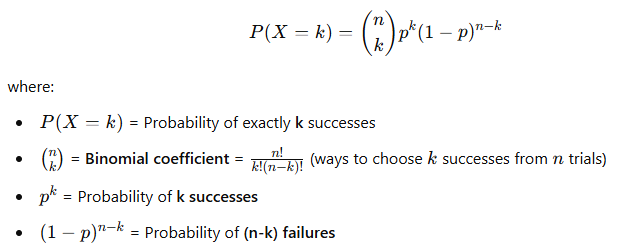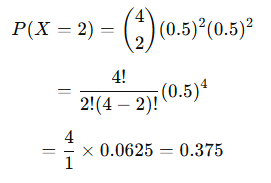The binomial distribution is a discrete probability distribution that models the number of successes in a fixed number of independent trials, where each trial has only two possible outcomes:
- Success (with probability p)
- Failure (with probability 1 – p)
It is commonly used in situations like flipping coins, quality control in manufacturing, and medical trials.
1. Conditions for a Binomial Distribution
A random experiment follows a binomial distribution if:
- Fixed Number of Trials (n) – The experiment is repeated n times.
- Independent Trials – The outcome of one trial does not affect the others.
- Two Possible Outcomes – Each trial has only two results (Success or Failure).
- Constant Probability (p) – The probability of success remains the same for all trials.
📌 Example:
A company produces light bulbs, and each bulb has a 5% chance of being defective. If we inspect 10 bulbs, we can model the number of defective bulbs using a binomial distribution with:
- n = 10 (fixed number of trials)
- p = 0.05 (probability of defect)
2. Binomial Probability Formula
The probability of getting exactly k successes in n trials is given by:

📌 Example:
If we toss a coin 4 times and want to find the probability of getting exactly 2 heads, we use:
- n = 4
- k = 2
- p = 0.5 (since heads has a 50% chance)

Thus, the probability of getting exactly 2 heads in 4 coin tosses is 0.375 (or 37.5%).
3. Mean and Variance of a Binomial Distribution
For a binomial distribution:
- Mean () = np
- Variance () = np(1−p)
- Standard Deviation () = [np(1−p)]^0.5
📌 Example:
If a multiple-choice test has 20 questions, and each question has 4 choices (one correct), then:
- n = 20
- p = 1/4 = 0.25 (since each question has a 25% chance of being correct)
- μ = 20 × 0.25 = → Expected correct answers
- σ= [20×0.25×0.75] ^0.5 = 3.75^0.5 ≈ 1.94
This means a student who guesses randomly can expect to get about 5 correct answers with a standard deviation of ~1.94.
4. Shape of a Binomial Distribution
- Symmetric if p = 0.5 (equal success/failure chance)
- Skewed Right if p < 0.5 (success is rare)
- Skewed Left if p > 0.5 (success is common)
📌 Example:
- If we flip a fair coin 10 times, the distribution is symmetrical.
- If we roll a die and count how often we get a 6, the distribution is right-skewed (since getting a 6 is rare: p=1/6).
5. Applications of Binomial Distribution
✅ Manufacturing – Defective vs. non-defective products
✅ Medical Trials – Success rate of a new drug
✅ Marketing – Probability of customers responding to an ad
✅ Sports – Free throw success in basketball
✅ Finance – Probability of stock price increasing on a given day
Conclusion
- Binomial distribution is useful for modeling “success/failure” experiments.
- It requires a fixed number of independent trials with a constant success probability.
- The probability formula helps determine the likelihood of getting a specific number of successes.
- The mean and variance describe the expected outcomes over many trials.